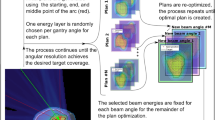Abstract
When using the beam scanning method for particle beam therapy, the target volume is divided into many iso-energy slices and is irradiated slice by slice. Each slice may comprise thousands of discrete scanning beam positions. An optimized scanning path can decrease the transit dose and may bypass important organs. The minimization of the scanning path length can be considered as a variation of the traveling salesman problem; the simulated annealing algorithm is adopted to solve this problem. The initial scanning path is assumed as a simple zigzag path; subsequently, random searches for accepted new paths are performed through cost evaluation and criteria-based judging. To reduce the optimization time of a given slice, random searches are parallelized by employing thousands of threads. The simultaneous optimization of multiple slices is realized by using many thread blocks of general-purpose computing on graphics processing units hardware. Running on a computer with an Intel i7-4790 CPU and NVIDIA K2200 GPU, our new method required only 1.3 s to obtain optimized scanning paths with a total of 40 slices in typically studied cases. The procedure and optimization results of this new method are presented in this work.





Similar content being viewed by others
Change history
23 April 2019
In the original article the authors affiliations are incorrectly published.
References
Y.H. Yang, M.Z. Zhang, D.M. Li, Simulation study of slow extraction for the Shanghai Advanced Proton Therapy facility. Nucl. Sci. Tech. 28, 120 (2017). https://doi.org/10.1007/s41365-017-0273-0
J.H. Kang, J.J. Wilkens et al., Demonstration of scan path optimization in proton therapy. Med. Phys. 34(9), 3457–3464 (2007). https://doi.org/10.1118/1.2760025
T. Inaniwa, T. Furukawa et al., Evaluation of hybrid depth scanning for carbon-ion radiotherapy. Med. Phys. 39(5), 2820–2825 (2012). https://doi.org/10.1118/1.4705357
Th Haberer, W. Becher, D. Schardt et al., Magnetic scanning system for heavy ion therapy. Nucl. Instrum Methods 330(1–2), 296–305 (1993). https://doi.org/10.1016/0168-9002(93)91335-K
M.F. Dias, M. Riboldi, J. Seco et al., Scan path optimization with/without clustering for active beam delivery in charged particle therapy. Physica Med. 31, 130–136 (2015). https://doi.org/10.1016/j.ejmp.2015.01.001
T. Inaniwa, T. Furukawa, T. Tomitani et al., Optimization for fast-scanning irradiation in particle therapy. Med. Phys. 34, 3302–3311 (2007). https://doi.org/10.1118/1.2754058
T. Furukawa, T. Inaniwa, S. Sato, T. Shirai et al., Performance of the NIRS fast scanning system for heavy-ion radiotherapy. Med. Phys. 37, 5672–5682 (2010). https://doi.org/10.1118/1.3501313
S.M. Zenklusen, E. Pedroni, D. Meer, A study on repainting strategies for treating moderately moving targets with proton pencil beam scanning at the new gantry 2 at psi. Phys. Med. Biol. 55, 5103–5121 (2010). https://doi.org/10.1118/1.3501313
C. Bert, M. Durante, Particle radiosurgery: a new frontier of physics in medicine. Phys. Medica 30(5), 535–538 (2014). https://doi.org/10.1016/j.ejmp.2014.04.011
A.C. Knopf, A.J. Lomax, In the context of radiosurgery-Pros and cons of rescanning as a solution for treating moving targets with scanned particle beams. Phys. Medica 30(5), 551–554 (2014). https://doi.org/10.1016/j.ejmp.2014.03.010
J. Pardo, M. Donetti, F. Bourhaleb et al., Heuristic optimization of the scanning path of particle therapy Beams. Med. Phys. 36(6), 2043–2051 (2009). https://doi.org/10.1118/1.3121506
C. Voudouris, E. Tsang, Guided local search and its application to the traveling salesman problem. Eur. J. Oper. Res. 113(2), 469–499 (1999). https://doi.org/10.1016/S0377-2217(98)00099-X
S. Kirkpatrick, C.D. Gelatt Jr., M.P. Vecchi, Optimization by simulated annealing. Science 220, 671–680 (1983). https://doi.org/10.1126/science.220.4598.671
Y. Xiang, S. Gubian, G. Suomela et al., Generalized simulated annealing for global optimization: the GenSA package. J. Mech. Eng. 5(1), 153–160 (2013). https://doi.org/10.32614/RJ-2013-002
E.R. Correia, V.B. Nascimento, C.M. de Castilho et al., The generalized simulated annealing algorithm in the low energy electron diffraction search problem. J. Phys.: Condens. Matter 17(1), 1–16 (2005). https://doi.org/10.1088/0953-8984/17/1/001
V.T. Vetterling, W.H. Press, S.A. Teukolsky, B.P. Flannery, Numerical Recipes Example Book (C++): The Art of Scientific Computing (Cambridge University Press, Cambridge, 2002)
NVIDIA Corporation. CUDA C programming guide. http://docs.nvidia.com/cuda/cuda-c-programming-guide/#axzz4lLlZaXLb. Accessed 10 Apr 2017
Author information
Authors and Affiliations
Corresponding author
Rights and permissions
About this article
Cite this article
Wu, C., Pu, YH. & Zhang, X. GPU-accelerated scanning path optimization in particle cancer therapy. NUCL SCI TECH 30, 56 (2019). https://doi.org/10.1007/s41365-019-0582-6
Received:
Revised:
Accepted:
Published:
DOI: https://doi.org/10.1007/s41365-019-0582-6




